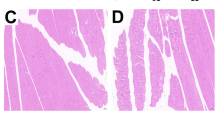Abstract
Examination of the antioxidative homeostasis in skeletal muscle cells in the presence or absence of selenoprotein W (SelW) is necessary to understand the importance of SelW in the antioxidative system. Depletion of SelW by RNA interference was achieved by introducing a synthetic small interfering RNA into the mouse skeletal muscle cell line C2C12 (C3H). Transfectant screening was performed by real-time reverse transcription-PCR, Western blotting, flow cytometry, fluorescence staining, cell viability, and glutathione assays. SelW expression and mRNA levels were downregulated by 62.1 and 72.4%, respectively. In addition, acute cytotoxicity and an apoptosis rate of ∼36% in SelW-depleted cells demonstrated that RNA interference was successful. As compared with non-SelW-depleted cells, the enzyme activities of glutathione peroxidase, superoxide dismutase, and catalase and total antioxidative capability and glutathione level increased by 47.6, 103.0, 31.0, 205.6, and 30.0%, respectively (P < 0.05). Thus, SelW is important for the antioxidative system of muscle cells. Depletion of SelW, however, could be compensated by other intracellular antioxidative enzymes because oxidative stress was not the causative factor for apoptosis in SelW-depleted cells. Thus, the main function of SelW in muscle cells is not in the antioxidative system.
Similar content being viewed by others
Abbreviations
- CAT:
-
catalase
- FITC:
-
fluorescein isothiocyanate
- GPx:
-
glutathione peroxidase
- GSH:
-
glutathione
- MTT:
-
3-(4,5-dimethylthiazol-2-yl)-2,5-diphenyltetrazolium bromide
- PI:
-
propidium iodide
- SelW:
-
selenoprotein W
- siRNA:
-
small interfering RNA
- SOD:
-
superoxide dismutases
- T-AOC:
-
total antioxidative capability
- WST-1:
-
2-(4-iodophenyl)-3-(4-nitro-phenyl)-5-(2,4-disulfophenyl)-2H-tetrazolium, monosodium salt
References
Pappas, A. C., Zoidis, E., Surai, P. F., and Zervas, G. (2008) Comp. Biochem. Physiol. B. Biochem. Mol. Biol., 151, 361–372.
Vendeland, S. C., Beilstein, M. A., Chen, C. L., Jensen, O. N., Barofsky, E., and Whanger, P. D. (1993) J. Biol. Chem., 268, 17103–17107.
Ream, L. W., Vorachek, W. R., and Whanger, P. D. (2003) in Selenium: Its Molecular Biology and Role in Human Health (Hatfield, D. L., ed.) Kluwer Academic Publishers, London, pp. 141–145.
Yeh, J. Y., Beilstein, M. A., Andrews, J. S., and Whanger, P. D. (1995) FASEB J., 9, 392–396.
Whanger, P. D. (2000) Cell Mol. Life Sci., 57, 1846–1852.
Gu, Q. P., Sun, Y., Ream, L. W., and Whanger, P. D. (2000) Mol. Cell Biochem., 204, 49–56.
Pagmantidis, V., Bermano, G., Villette, S., Broom, I., Arthur, J., and Hesketh, J. (2005) FEBS Lett., 579, 792–796.
Papp, L. V., Lu, J., Holmgren, A., and Khanna, K. K. (2007) Antioxid. Redox. Signal., 9, 775–806.
Lu, J., and Holmgren, A. (2009) J. Biol. Chem., 284, 723–727.
Beilstein, M. A., Vendeland, S. C., Barofsky, E., Jensen, O. N., and Whanger, P. D. (1996) J. Inorg. Biochem., 61, 117–124.
Gu, Q. P., Beilstein, M. A., Vendeland, S. C., Lugade, A., Ream, W., and Whanger, P. D. (1997) Gene, 193, 187–196.
Whanger, P. D., Vendeland, S. C., Gu, Q. P., Beilstein, M. A., and Ream, L. W. (1997) Biomed. Environ. Sci., 10, 190–197.
Jeong, D., Kim, T. S., Chung, Y. W., Lee, B. J., and Kim, I. Y. (2002) FEBS Lett., 517, 225–228.
Bauman, A. T., Malencik, D. A., Barofsky, D. F., Barofsky, E., Anderson, S. R., and Whanger, P. D. (2004) Biochem. Biophys. Res. Commun., 313, 308–313.
Loflin, J., Lopez, N., Whanger, P. D., and Kioussi, C. (2006) J. Inorg. Biochem., 100, 1679–1684.
Aachmann, F. L., Fomenko, D. E., Soragni, A., Gladyshev, V. N., and Dikiy, A. (2007) J. Biol. Chem., 282, 37036–37044.
Dikiy, A., Novoselov, S. V., Fomenko, D. E., Sengupta, A., Carlson, B. A., Cerny, R. L., Ginalski, K., Grishin, N. V., Hatfield, D. L., and Gladyshev, V. N. (2007) Biochemistry, 46, 6871–6882.
Sun, Y., Gu, Q. P., and Whanger, P. D. (2001) J. Inorg. Biochem., 84, 151–156.
Yeh, J. Y., Ou, B. R., Forsberg, N. E., and Whanger, P. D. (1997) BioMetals, 10, 11–22.
Jia, J. H., Wang, Y., Cao, Y. B., Gao, P. H., Jia, X. M., Ma, Z. P., Xu, Y. G., Dai, B. D., and Jiang, Y. Y. (2007) Biochem. Biophys. Res. Commun., 359, 163–167.
Linke, K., and Jakob, U. (2003) Antioxid. Redox. Signal., 5, 425–434.
Ghezzi, P. (2005) Free Radic. Res., 39, 573–580.
Barzilai, A., Rotman, G., and Shiloh, Y. (2002) DNA Repair (Amst)., 1, 3–25.
Gille, G., and Sigler, K. (1995) Folia Microbiol., 40, 131–152.
Hirota, K., Matsui, M., Iwata, S., Nishiyama, A., Mori, K., and Yodoi, J. (1997) Proc. Natl. Acad. Sci. USA, 94, 3633–3638.
Karimpour, S., Lou, J., Lin, L. L., Rene, L. M., Ma, X., and Karra, S. (2002) Oncogene, 21, 6317–6327.
Hattori, H., Imai, H., Furuhama, K., Sato, O., and Nakagawa, Y. (2005) Biochem. Biophys. Res. Commun., 337, 464–473.
Nordberg, J., and Arner, E. S. J. (2001) Free Radic. Biol. Med., 31, 1287–1312.
Xia, L., Nordman, T., Olsson, J. M., Damdimopoulos, A., Bjorkhem-Bergman, L., Nalvarte, I., Eriksson, L. C., Arner, E. S. J., Spyrou, G., and Bjorstedt, M. (2003) J. Biol. Chem., 278, 2141–2146.
Yusof, Y. A. M., Ahmad, N., Das, S., Sulaiman, S., and Murad, N. A. (2009) African J. Tradition., Compliment. Altern. Med., 6, 87–93.
Lescure, A., Rederstorff, M., Krol, A., Guicheney, P., and Allamand, V. (2009) Biochim. Biophys. Acta, 1790, 1569–1574.
Author information
Authors and Affiliations
Corresponding author
Additional information
Published in Russian in Biokhimiya, 2010, Vol. 75, No. 2, pp. 247–255.
Originally published in Biochemistry (Moscow) On-Line Papers in Press, as Manuscript BM09-197, January 17, 2010.
Electronic supplementary material
Rights and permissions
About this article
Cite this article
Wang, XL., Yang, CP., Xu, K. et al. Selenoprotein W depletion in vitro might indicate that its main function is not as an antioxidative enzyme. Biochemistry Moscow 75, 201–207 (2010). https://doi.org/10.1134/S0006297910020100
Received:
Revised:
Published:
Issue Date:
DOI: https://doi.org/10.1134/S0006297910020100




